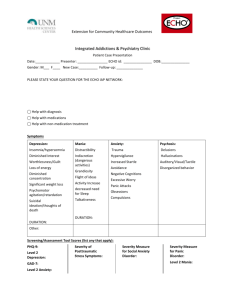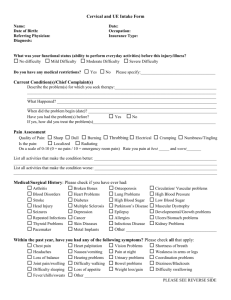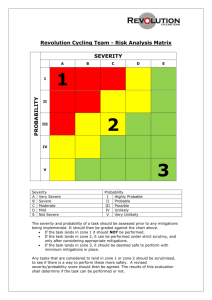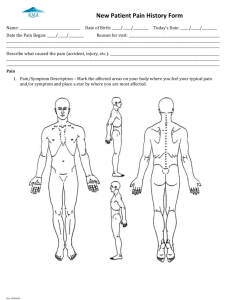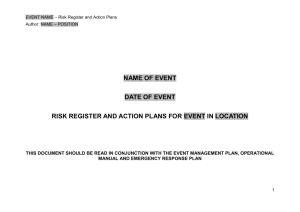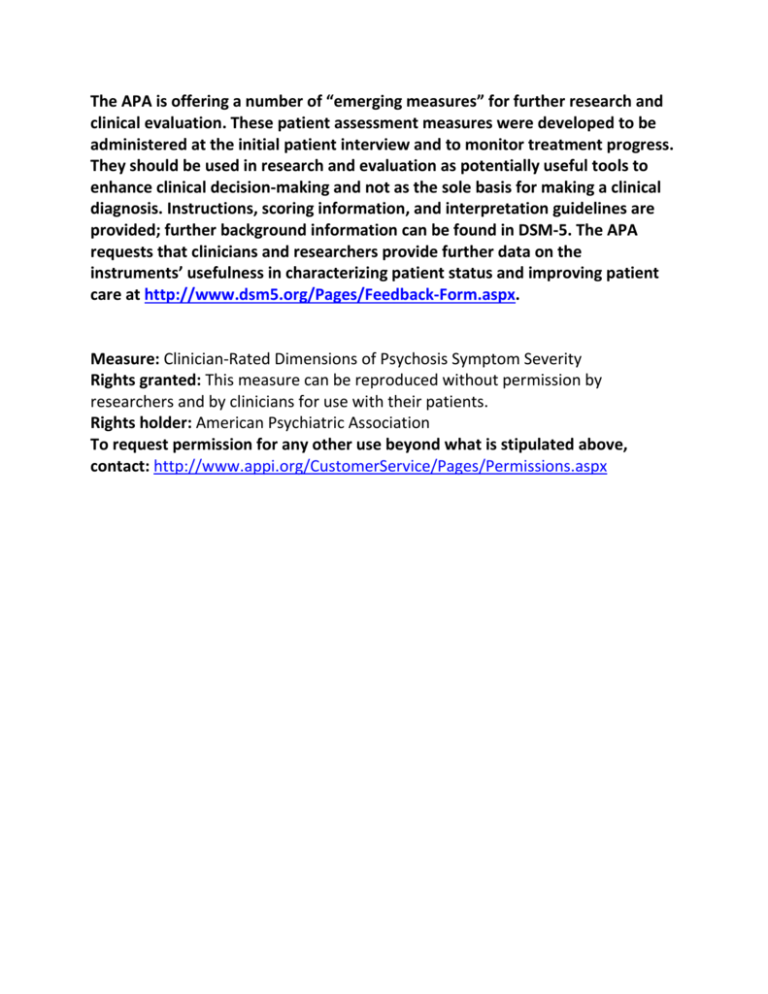
The APA is offering a number of “emerging measures” for further research and
clinical evaluation. These patient assessment measures were developed to be
administered at the initial patient interview and to monitor treatment progress.
They should be used in research and evaluation as potentially useful tools to
enhance clinical decision-making and not as the sole basis for making a clinical
diagnosis. Instructions, scoring information, and interpretation guidelines are
provided; further background information can be found in DSM-5. The APA
requests that clinicians and researchers provide further data on the
instruments’ usefulness in characterizing patient status and improving patient
care at http://www.dsm5.org/Pages/Feedback-Form.aspx.
Measure: Clinician-Rated Dimensions of Psychosis Symptom Severity
Rights granted: This measure can be reproduced without permission by
researchers and by clinicians for use with their patients.
Rights holder: American Psychiatric Association
To request permission for any other use beyond what is stipulated above,
contact: http://www.appi.org/CustomerService/Pages/Permissions.aspx
Clinician-Rated Dimensions of Psychosis Symptom Severity
Name:________________________________
Age: _______
Sex: [
] Male
[
] Female
Date:________________
Instructions: Based on all the information you have on the individual and using your clinical judgment, please rate (with checkmark) the
presence and severity of the following symptoms as experienced by the individual in the past seven (7) days.
Domain
0
1
2
3
4
I. Hallucinations
Not
present
Equivocal (severity or
duration not sufficient
to be considered
psychosis)
Present, but mild
(little pressure to act
upon voices, not very
bothered by voices)
Present and moderate
(some pressure to
respond to voices, or is
somewhat bothered by
voices)
Present and severe
(severe pressure to
respond to voices, or
is very bothered by
voices)
II. Delusions
Not
present
Equivocal (severity or
duration not sufficient
to be considered
psychosis)
Present, but mild
(little pressure to act
upon delusional beliefs,
not very bothered by
beliefs)
Present and moderate
(some pressure to act
upon beliefs, or is
somewhat bothered by
beliefs)
Present and severe
(severe pressure to
act upon beliefs, or is
very bothered by
beliefs)
III. Disorganized
speech
Not
present
Equivocal (severity or Present, but mild
duration not sufficient (some difficulty
to be considered
following speech)
disorganization)
Present and moderate Present and severe
(speech often difficult to (speech almost
follow)
impossible to follow)
IV. Abnormal
psychomotor
behavior
Not
present
Equivocal (severity or
duration not sufficient
to be considered
abnormal psychomotor
behavior)
Present, but mild
(occasional abnormal or
bizarre motor behavior
or catatonia)
Present and moderate
(frequent abnormal or
bizarre motor behavior
or catatonia)
Present and severe
(abnormal or bizarre
motor behavior or
catatonia almost
constant)
V. Negative
symptoms
(restricted
emotional
expression or
avolition)
Not
present
Equivocal decrease in
facial expressivity,
prosody, gestures, or
self-initiated behavior
Present, but mild
decrease in facial
expressivity, prosody,
gestures, or
self-initiated behavior
Present and moderate
decrease in facial
expressivity, prosody,
gestures, or self-initiated
behavior
Present and severe
decrease in facial
expressivity, prosody,
gestures, or
self-initiated behavior
VI. Impaired
cognition
Not
present
Equivocal (cognitive
function not clearly
outside the range
expected for age or
SES; i.e., within 0.5 SD
of mean)
Present, but mild
(some reduction in
cognitive function;
below expected for age
and SES, 0.5–1 SD from
mean)
Present and moderate
(clear reduction in
cognitive function;
below expected for age
and SES, 1–2 SD from
mean)
Present and severe
(severe reduction in
cognitive function;
below expected for
age and SES, > 2 SD
from mean)
VII. Depression
Not
present
Equivocal
(occasionally feels sad,
down, depressed, or
hopeless; concerned
about having failed
someone or at
something but not
preoccupied)
Present, but mild
(frequent periods of
feeling very sad, down,
moderately depressed,
or hopeless; concerned
about having failed
someone or at
something, with some
preoccupation)
Present and moderate
(frequent periods of
deep depression or
hopelessness;
preoccupation with guilt,
having done wrong)
Present and severe
(deeply depressed or
hopeless daily;
delusional guilt or
unreasonable
self-reproach grossly
out of proportion to
circumstances)
VIII. Mania
Not
present
Equivocal (occasional
elevated, expansive, or
irritable mood or some
restlessness)
Present, but mild
(frequent periods of
somewhat elevated,
expansive, or irritable
mood or restlessness)
Present and moderate
(frequent periods of
extensively elevated,
expansive, or irritable
mood or restlessness)
Present and severe
(daily and extensively
elevated, expansive,
or irritable mood or
restlessness)
Score
Note. SD = standard deviation; SES = socioeconomic status.
Copyright © 2013 American Psychiatric Association. All Rights Reserved.
This material can be reproduced without permission by researchers and by clinicians for use with their patients.
Instructions to Clinicians
The Clinician-Rated Dimensions of Psychosis Symptom Severity is an 8-item measure that assesses the severity of
mental health symptoms that are important across psychotic disorders, including delusions, hallucinations,
disorganized speech, abnormal psychomotor behavior, negative symptoms (i.e., restricted emotional expression or
avolition), impaired cognition, depression, and mania. The severity of these symptoms can predict important
aspects of the illness, such as the degree of cognitive and/or neurobiological deficits. The measure is intended to
capture meaningful variation in the severity of symptoms, which may help with treatment planning, prognostic
decision-making, and research on pathophysiological mechanisms. The measure is completed by the clinician at
the time of the clinical assessment. Each item asks the clinician to rate the severity of each symptom as
experienced by the individual during the past 7 days.
Scoring and Interpretation
Each item on the measure is rated on a 5-point scale (0=none; 1=equivocal; 2=present, but mild; 3=present and
moderate; and 4=present and severe) with a symptom-specific definition of each rating level. The clinician may
review all of the individual’s available information and, based on clinical judgment, select () the level that most
accurately describes the severity of the individual’s condition. The clinician then indicates the score for each item
in the “Score” column provided. The response on each item should be interpreted independently when assessing
the severity of the psychotic disorder.
Frequency of Use
To track changes in the individual’s symptom severity over time, the measure may be completed at regular
intervals as clinically indicated, depending on the stability of the individual’s symptoms and treatment status.
Consistently high scores on a particular domain may indicate significant and problematic areas for the individual
that might warrant further assessment, treatment, and follow-up. Clinical judgment should guide decision making.
Copyright © 2013 American Psychiatric Association. All Rights Reserved.
This material can be reproduced without permission by researchers and by clinicians for use with their patients.



